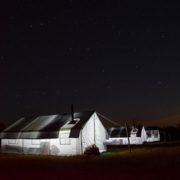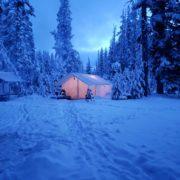Choosing the Perfect Canvas Wall Tent: A Guide with Elk Mountain Tents
/in Blog Articles/by Jason LittleCanvas wall tents are a popular choice among campers and outdoor enthusiasts, providing a sturdy and comfortable shelter in the wilderness. However, choosing the right canvas wall tent can be overwhelming with various options available in the market. In this article, we will explore how to choose a canvas wall tent, and how Elk Mountain Tents can help with your selection.
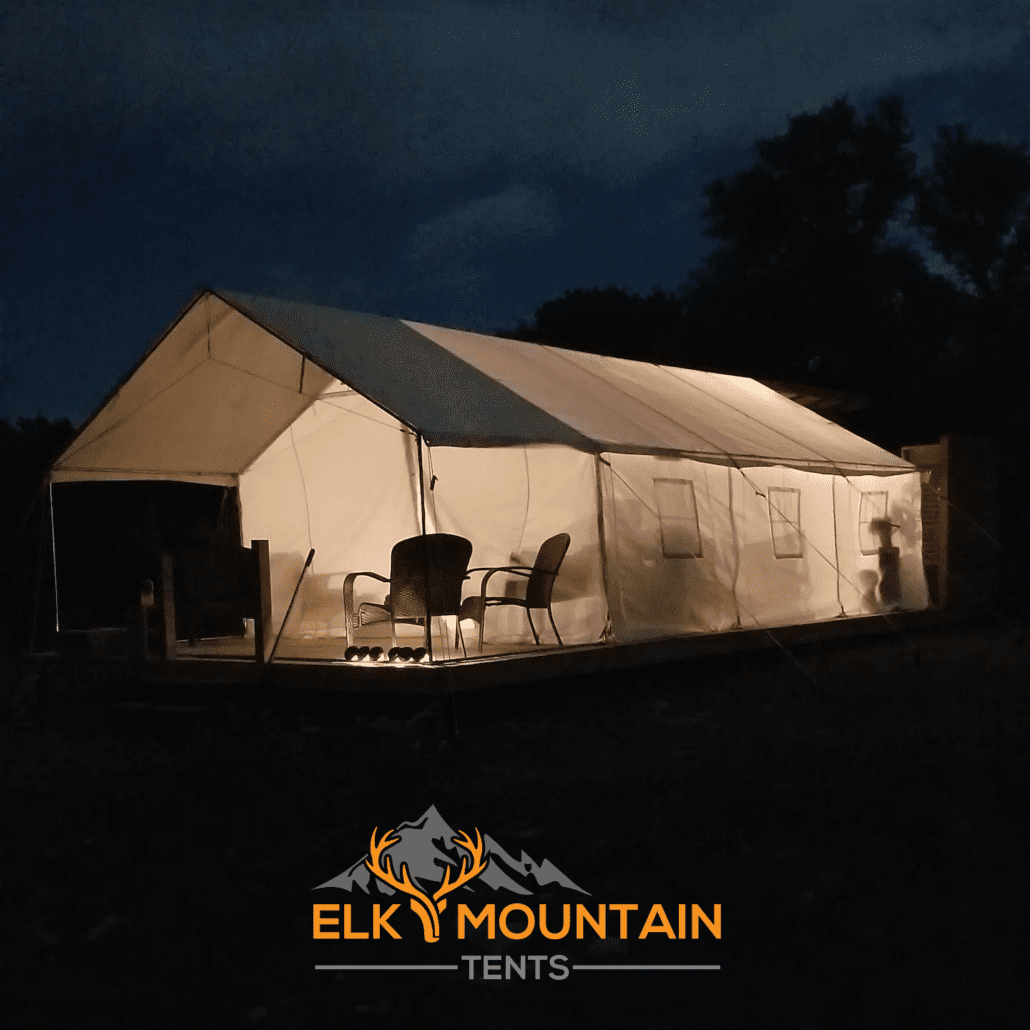
Elk Mountain Tents:
Elk Mountain Tents is a company that specializes in high-quality canvas wall tents for outdoor use. They offer a wide range of canvas tents, with different sizes, styles, and features to suit different needs and preferences.
Choosing a Canvas Wall Tent:
There are several factors to consider. These include:
Size:
The size of the tent will depend on the number of people who will be using it and the amount of gear that needs to be stored inside. 8×8 is about as small as canvas tents come, but we find that most people end up preferring sizes 13×13 or larger, especially for groups with gear, so our wall tents begin at that size. Headroom is pretty standard for wall tents, with side walls – the lowest point in the tent – being 4 or 5 ft, making most of the room very tall-friendly, allowing you to comfortably stand. But the biggest factors in determinging the right size will likely be how many people and how much gear. For a more detailed breakdown, check out our canvas tent sleeping capacity article.
Material:
Canvas tents are usually made from cotton or polyester or a blend of the two. All are very durable and suitable for most needs. You’ll find that the weight of the material generally varies from 8-14 oz with the industry standard being more like 10-12 oz. The weight of the material correlates pretty closely to strength but it’s not a one-to-one match. For example, the unique material used by Elk Mountain Tents is an 11 oz weight but a break and tear strength closer to 13 oz. Cotton is considered more breathable, but that too can vary from manufacturer to manufacturer and becomes irrelevant with proper ventilation. Lastly, understand that cotton is an organic material that is subject to mold and rot if not properly treated and taken care of.

Features:
Canvas tents can come with a range of features, such as windows, doors, awnings, stove jacks, and ventilation systems. These features can greatly impact the comfort and convenience of your camping experience. However, they can greatly impact the price as well. When getting quotes from tent companies, be sure to include all of the features you want in your request. Many companies will include a variety of features in their standard model for a flat fee. Others focus on custom orders which add flexibility but require a longer wait for the tent to be completed.
Weather Resistance:
The tent should be able to withstand different weather conditions, such as rain, wind, and sun exposure. Any canvas should be able to withstand all of these given the proper preparation. If you go with cotton canvas, be sure to have the material treated for water and sun at a minimum. Fire treatment is additional and recommended if you want to use a stove. 100% polyester canvas is naturally waterproof and requires no treatments for rain and sun. Treating polyester canvas is possible but most choose not to bother. Polyester canvas can be treated for fire as well but most choose to purchase a heat shield as these are easier. Whether you choose polyester or cotton, getting a rainfly will protect the tent from the natural wear and tear of the weather.
Ease of Setup:
Some canvas tents can be more challenging to set up than others, so it’s important to consider how easy or difficult the setup process will be. Remember that these are large tents, so any option will be more challenging than a dome tent. It’s possible to set these up by yourself but much easier with another person. Lastly, a sewn-in floor can make setup a pain.
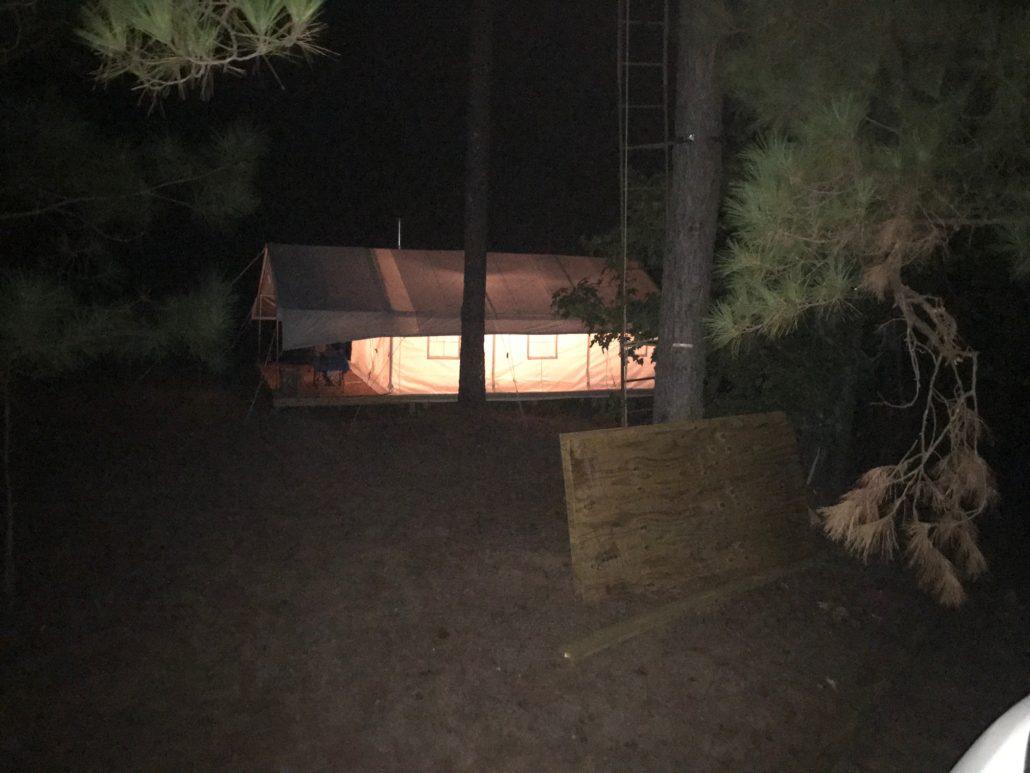
FAQs
Q: What size canvas tent should I choose?
A: The size of the tent will depend on the number of people who will be using it and the amount of gear that needs to be stored inside. Elk Mountain Tents offers canvas tents in different sizes, ranging from medium 10×13 tents to extra large 13×20 tents, with bell tents ranging from 13 ft diameter to 20 ft diameter.
Q: What material should I choose for my canvas tent?
A: Canvas tents can be made from cotton or polyester or a blend. All of these are made of a durable material, while polyester will be slightly stronger for its weight and easier to care for. Elk Mountain Tents uses a unique polyester canvas for their tents.
Q: What features should I look for in a canvas tent?
A: Canvas tents can come with a range of features, such as windows, doors, stove jacks, awnings, and ventilation systems. Additionally, there are a variety of treatments for cotton canvas available. Remember that some treatments need to be redone every few years.
Q: How weather-resistant are canvas tents?
A: Cotton canvas tents can be weather-resistant if they are treated properly. Elk Mountain Tents uses a material that requires no additional treatments for sun and rain.
conclusion:
Choosing the right canvas wall tent involves considering several factors, such as size, material, features, weather resistance, and ease of setup. Elk Mountain Tents offers a wide range of high-quality canvas tents, with different sizes, styles, and features to suit different needs and preferences. By considering these factors and choosing a canvas tent from Elk Mountain Tents, you can enjoy a comfortable and memorable camping experience in the great outdoors.
Guide to Seasoning or Weathering Your Canvas Tent: Tips from Elk Mountain Tents
/in Blog Articles/by Jason LittleIntroduction:
Camping in a canvas tent is a unique experience that can provide you with a comfortable and cozy shelter in the great outdoors. However, to ensure the longevity and effectiveness of your canvas tent, you need to properly season or weather it. Seasoning or weathering a tent can refer to two different processes and this article will touch on both of them.
If you own a canvas tent from Elk Mountain Tents, you’re in luck. They offer some of the best quality canvas tents for sale on the market, and more relevant to this article – their unique canvas material requires no weathering or additional treatments, so your tent can last for many years to come… and you really don’t need to read most of this article since it’s primarily about what to do with cotton canvas. Anyway, in this guide, you’ll learn the best tips and tricks for seasoning or weathering a *cotton* canvas tent, but if there’s something relevent to an Elk Mountain Tent, I’ll point those out along the way.
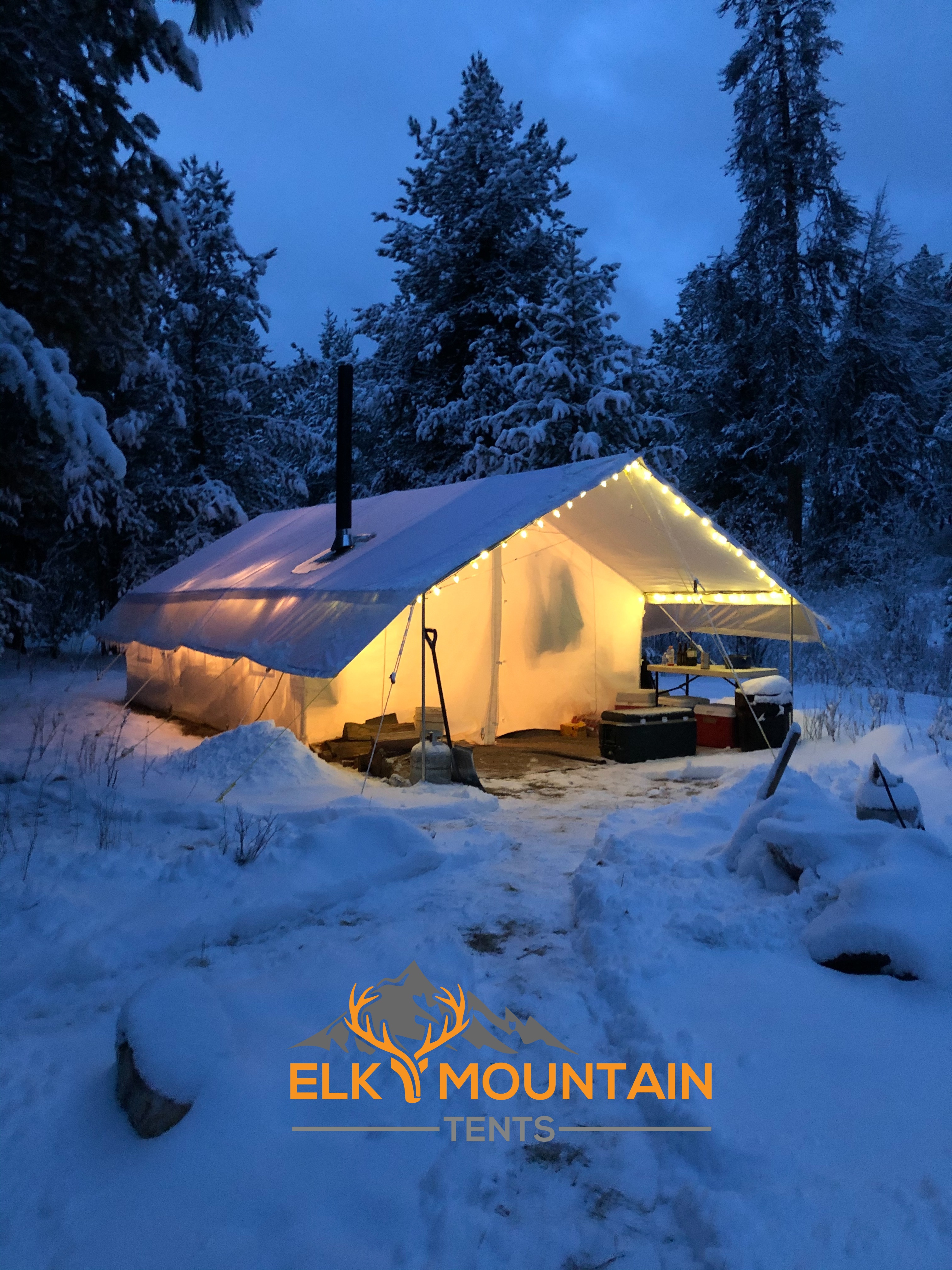
I. Understanding the importance of seasoning or weathering your canvas tent
When you first receive your cotton canvas tent, it’s essential to season or weather it before using it for camping. Cotton canvas used in most canvas tents is not naturally waterproof, and without seasoning, water can seep through the canvas, causing leaks and damaging the fabric.
Cotton is a thick fabric of little strings bound together, and there are holes between these strings. The cotton will also shrink a little after the first few instances of getting wet. So, seasoning a tent essentially involves two steps: 1) getting the tent wet so you can speed up the shrinking process. This sounds like a bad thing but the shrinking means that those little holes are getting tighter. This alone is enough for many people to feel their canvas is water resistant enough. However, most people got the extra step, and 2) Apply different treatments, in particular a waterproofing treatment, to the canvas to fill in the remaining little holes.
Seasoning your tent is also essential for improving its durability. The seasoning process involves shrinking the canvas and impregnating the canvas fibers with a waterproofing solution, making them more resistant to rot, mold, and mildew. This also helps to reduce the risk of your tent fabric becoming damaged by UV rays, which can cause the material to break down over time.
The material used in Elk Mountain Tents’ tents is naturally waterproof and cannot rot because it is a synthetic material. The holes do not need to be shrunken and then filled in like cotton canavs. That said, it can still be treated for fire protection (see our FAQ section), and it’s generally recommended to get a rainfly to protect the material from all elements to ensure that it lasts for decades.

II. How to season or weather your canvas tent
Here are the steps to follow when seasoning or weathering your canvas tent:
- Set up your tent: First, set up your canvas tent in a dry and shaded area. Ensure the tent is properly pitched and taut to avoid wrinkles and air pockets, which can affect the application of the waterproofing solution.
- Clean the tent: If your tent is brand new, you can skip this step. Use a soft brush or sponge and cold water to clean the tent. Avoid using soap, detergent, or hot water, as these can damage the canvas material. Allow the tent to air dry completely before moving on to the next step.
- Wet down the tent: Spray the tent gently with a hose or sprinkler. Every part that has cotton canvas needs to get wet.
- Dry the tent: Leave your tent set up until it has dried fully. The tent may shrink by up to 5% but this is natural and will happen eventually, so you’re just shrinking it ahead of time so your additional treatments can be more effective. Avoid exposure to direct sunlight if possible to avoid UV damage.
- (optional) Repeat: Repeat steps 3 and 4 one more time if you would like to ensure maximum weathering.
- Apply the waterproofing solution: We recommends using a water-based waterproofing solution such as Canvak, Aqua-Tite Green, or Nikwax. These solutions are environmentally friendly and won’t harm the canvas fibers. Apply the waterproofing solution to the canvas fabric using a soft-bristled brush, roller, or spray bottle. Be sure to cover all areas of the tent, including the seams and zippers.
- Allow the tent to dry again: Once the waterproofing solution has been applied, allow the tent to dry completely in a dry and shaded area. Avoid exposure to direct sunlight if possible to avoid UV damage.
- Notes: Waterproofing is supposed to be reapplied each year but you can probably get away with doing it every other year. And, again, the tents from Elk Mountain Tents require no weathering or seasoning or added treatments; You can optionally apply a protective layer of Nikwax but you will get more protection from just having an added rainfly (also not required).
Honestly, it’s a huge pain. There’s a lot of time and effort required. And the alternative isn’t that much better – pay someone to do it. If you buy cotton canvas tent, the shop will inevitably offer you a variety of treatments… for a price. That said, though, this isn’t just an upsell; yes, it’s super expensive for each one, but the tent itself is expensive, and you don’t want it to get ruined, so it’s a very expensive but worthwhile investment. Again, if you are buying cotton canvas, you will want to pay for the rain, sun, and mold treatments.
III. Tips for maintaining your seasoned canvas tent
Here are some additional tips for maintaining your seasoned canvas tent:
- Avoid storing your tent when it’s damp or wet. Always allow it to dry completely before packing it away.
- Store your tent in a dry and cool place, away from direct sunlight and heat sources.
- Avoid using harsh chemicals or detergents to clean your tent, as these can damage the canvas
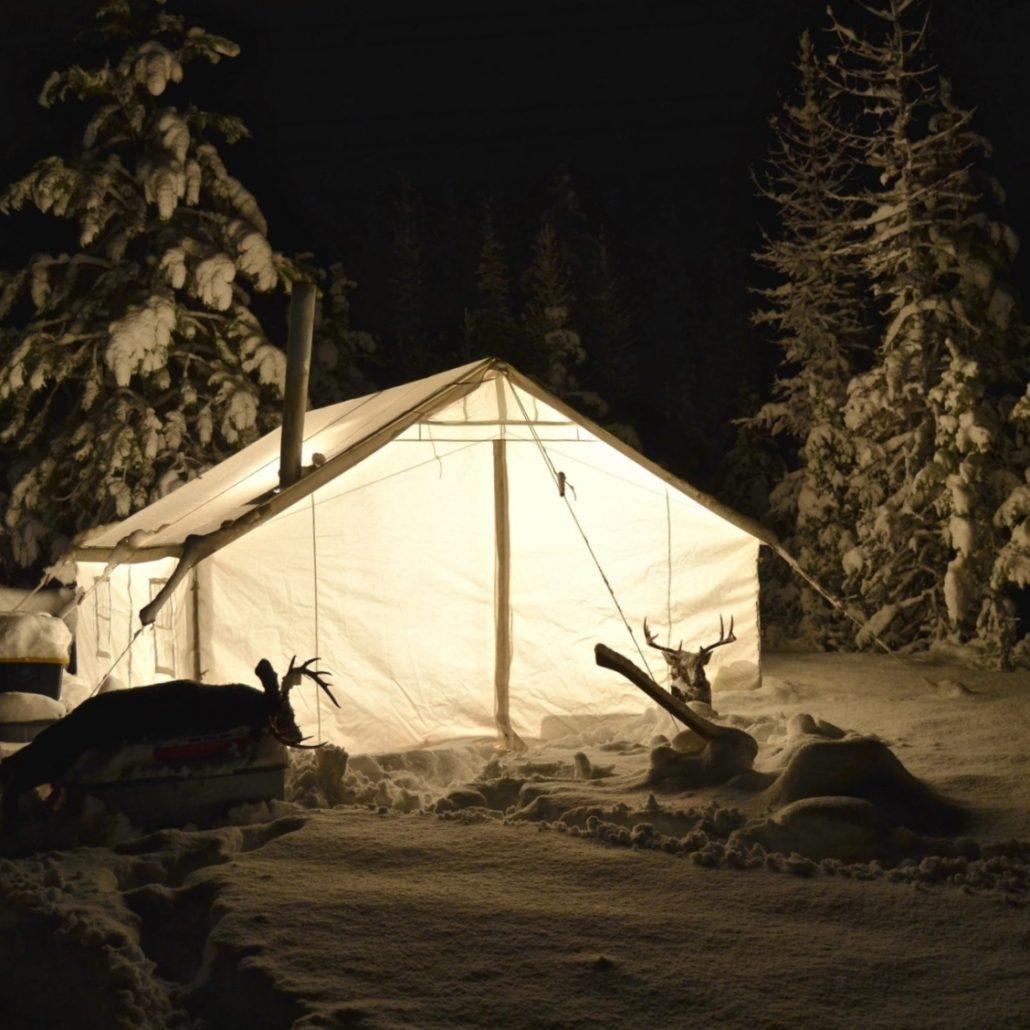
IV. Frequently asked questions (FAQs)
Q: What is the best time to season or weather your canvas tent?
A: It’s best to season or weather your canvas tent before its first use. This will ensure that it’s properly protected and will last longer. Pick a sunny and dry day.
Q: How often should I season or weather my canvas tent?
A: It’s recommended to season your canvas tent every few years or as needed. This will help to maintain its water resistance and durability. But it may season itself just by getting some rain. It’s the waterproofing that will need to be applied regularly.
Q: Can I use any waterproofing solution on my canvas tent?
A: It’s important to use a waterproofing solution that is compatible with the canvas material used in your tent. We recommend using water-based solutions for cotton canvas such as Canvak, Aqua-Tite Green, or Nikwax. However, if your tent has synthetic fibers, you’ll want a solution specific to your material. Elk Mountain Tents’s tents are all naturally waterproof but can still be treated with some kinds of solutions.
Q: Can I use my canvas tent without seasoning it?
A: Yes, you can use your canvas tent without seasoning it. However, without seasoning, the tent may be less water-resistant and less durable, which can affect its lifespan. It can also be impacted by UV light more.
Q: Can I machine wash my canvas tent?
A: What would that even look like?? What kind of machine is this?? I’m gonna just go ahead and say it’s not recommended to machine wash your canvas tent. Instead, use a soft brush or sponge and cold water to clean the tent.
Conclusion:
Seasoning or weathering your canvas tent is an essential step to ensure that it’s properly protected and will last longer. By following the steps and tips provided in this guide, you can properly season your canvas tent and maintain its water resistance and durability. Elk Mountain Tents offers high-quality canvas tents that don’t need any of these expensive treatments 🙂

CONTACT US
ELK MOUNTAIN TENTS
Nampa, Idaho 83687
(208) 506-5839
[email protected]
We’re on Facebook!
About Our Canvas Tents
Archive
- April 2024
- March 2024
- February 2024
- December 2023
- November 2023
- October 2023
- September 2023
- August 2023
- July 2023
- June 2023
- May 2023
- April 2023
- March 2023
- February 2023
- January 2023
- June 2022
- May 2022
- April 2022
- February 2022
- January 2022
- December 2021
- November 2021
- October 2021
- September 2021
- August 2021
- July 2021
- June 2021
- May 2021
- April 2021
- March 2021
- February 2021
- January 2021
- December 2020
- November 2020
- October 2020
- September 2020
- August 2020
- July 2020
- June 2020
- April 2020
- March 2020
- February 2020
- January 2020
- November 2019
- October 2019
- March 2019
- February 2019
- January 2019
- December 2018
- November 2018
- October 2018
- August 2018
- June 2018
- September 2017
- August 2017
- July 2017
- June 2017
- May 2017

